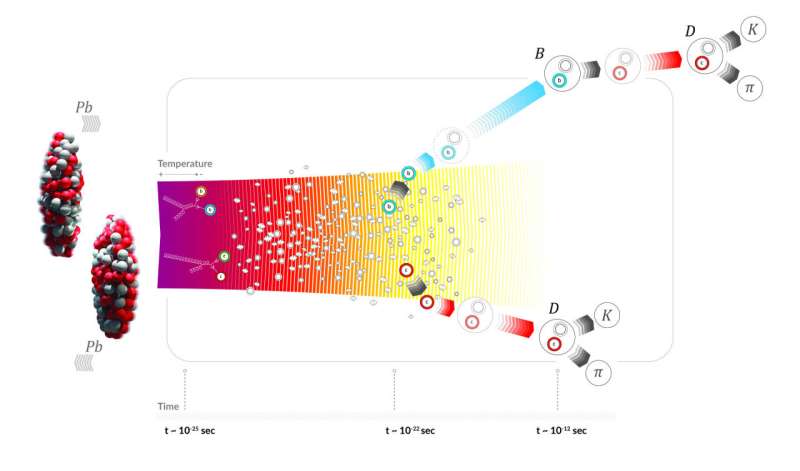This article has been reviewed according to Science X's editorial process and policies. Editors have highlighted the following attributes while ensuring the content's credibility:
fact-checked
preprint
trusted source
proofread
New ALICE measurements shed light on the dynamics of charm and beauty particles in quark-gluon plasma

When two lead ions collide at the Large Hadron Collider (LHC), they produce an extremely hot and dense state of matter in which quarks and gluons are not confined inside composite particles called hadrons. This fireball of particles—known as quark–gluon plasma and believed to have filled the universe in the first few millionths of a second after the Big Bang—expands and cools down rapidly. The quarks and gluons then transform back into hadrons, which fly out of the collision zone towards particle detectors.
In collisions where the two lead ions do not collide head on, the overlap region between the ions has an elliptic shape that leaves an imprint on the flow of hadrons. Measurements of such elliptic flow provide a powerful way to study quark–gluon plasma. In a recent paper posted to the arXiv preprint server, the ALICE collaboration reported a new measurement of the elliptic flow of hadrons containing heavy quarks, which are particularly powerful probes of the plasma.
Unlike the gluons and light quarks that make up the bulk of the quark–gluon plasma created in heavy-ion collisions, heavy charm and beauty quarks are produced in the initial stages of the collisions, before the plasma forms. They therefore interact with the plasma throughout its entire evolution, from its expansion and cooling to its transformation into hadrons.
Multiple interactions with the plasma's constituents bring heavy quarks into thermal equilibrium with the medium within a time that is inversely proportional to the quark's mass. Charm quarks are lighter than beauty quarks, so a shorter thermalization time and a larger degree of thermalization is expected for charm quarks than beauty quarks.
Once they thermalize with the plasma, charm quarks form D mesons and beauty quarks form B mesons, by combining with the medium's light quarks (see figure above). Previous measurements have shown that the elliptic flow of such "prompt" D mesons, so named because they are produced right after the collisions, is almost as strong as that of the lightest hadrons, pions. Because the thermalization time is expected to be longer for beauty quarks than charm quarks, the elliptic flow of B mesons is predicted to be weaker than that of prompt D mesons.
In its recent analysis of non-head-on lead–lead collisions that occurred during Run 2 of the LHC, the ALICE collaboration measured the elliptic flow of B mesons, by measuring the flow of "non-prompt" D mesons that are produced in the decays of B mesons. Key to the analysis was the adoption of a machine-learning technique to separate the products of the decay of non-prompt D mesons from those of the prompt ones, as well as to suppress the many background particle processes that mimic D meson production and decay.
The new measurement shows that the elliptic flow of the non-prompt D mesons is weaker than that of their prompt counterparts, in agreement with the expectation. The result sheds new light on the thermalization of beauty quarks in the quark–gluon plasma, and paves the way for new ALICE measurements based on data from Run 3 of the LHC.
With 40 times more collisions than the total recorded by ALICE in its previous periods of heavy-ion data taking, the new sample of lead–lead collisions taken in 2023 will allow the flow of charm and beauty particles to be studied in greater detail, shedding further light on their dynamics in the quark–gluon plasma.
More information: Measurement of Non-prompt D0-meson Elliptic Flow in Pb-Pb Collisions at √sNN = 5.02 TeV, arXiv (2023). DOI: 10.48550/arxiv.2307.14084
Journal information: arXiv
Provided by CERN





















